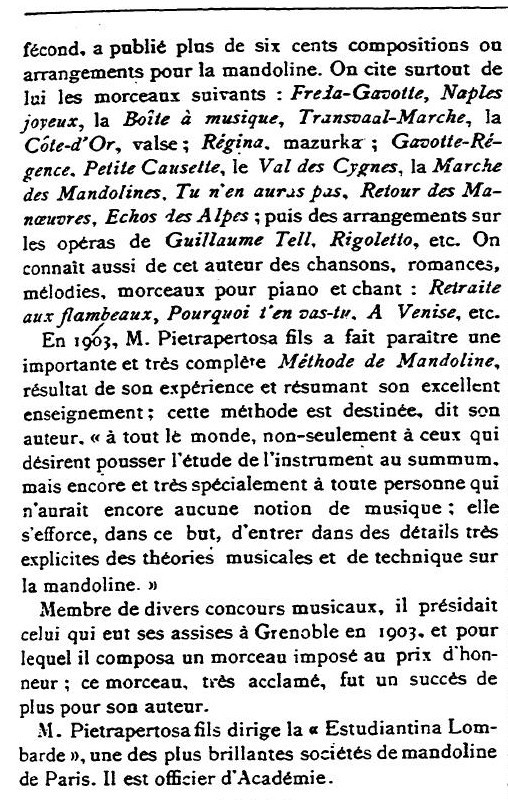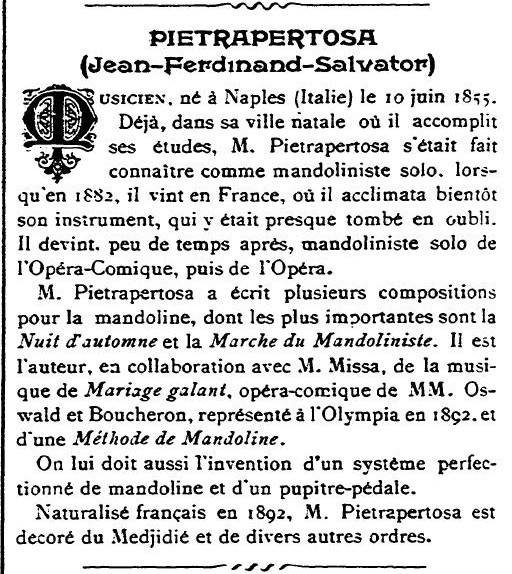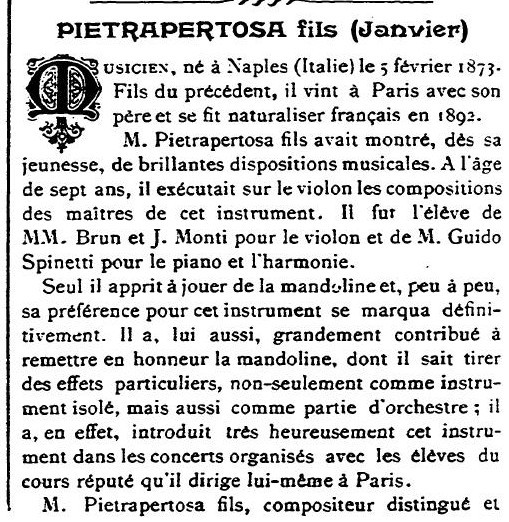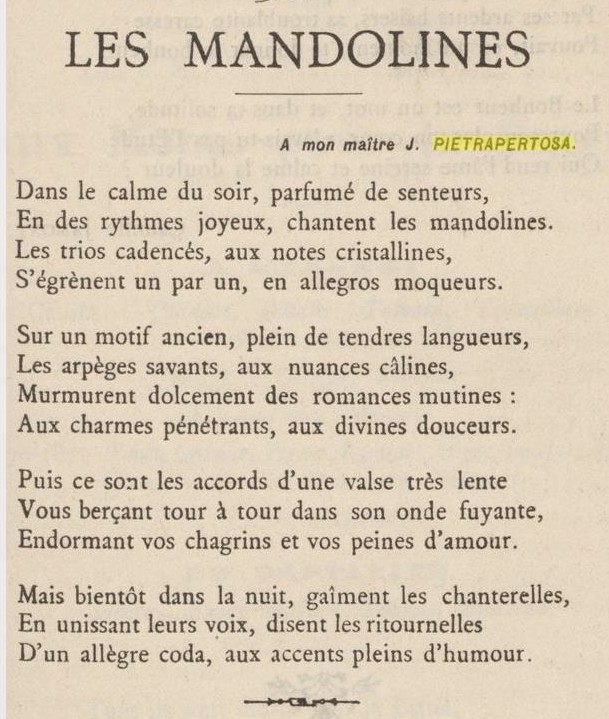Jean und Janvier Pietrapertosa belong to the mandolin players and mandolin teachers that helped to make the mandolin popular in the region of Paris in France around 1900.Both have written important mandolin methods , they have composed their own pieces and and arranged the popular music of the time.
Until today not much is known about the biographies of father and son Pietrapertosa. In many cases no difference is made between the two as if it was just one person namend J. Pietrapertosa.
I have recently found a document – a dictionary about the contemporaries – that contains short biographies of both – the father Jean Pietrapertosa and his son Janvier Pietrapertosa. The book that can be found in the French National Library bnf is dated to 1906, the copy from archive.org is dated to some years later.
Dictionnaire national des contemporains: contenant les notices des membres de l’Institut de France, du gouvernement et du parlement français, de l’Académie de médecine…. T. 5 / sous la dir. de C.-E. Curinier (1906) http://gallica.bnf.fr/ark:/12148/bpt6k82888j.image
The same book at archive.org: https://archive.org/stream/dictionnairenati05curiuoft#page/n73/mode/2up
Father: Jean-Ferdinand-Salvator Pietrapertosa
PIETRAPERTOSA (Jean-Ferdinand-Salvator)
Musicien, né à Naples (Italie) le 10 juin 1855.
Déjà, dans sa ville natale où il accomplit ses études, M. Pietrapertosa s’était fait connaître comme mandoliniste solo, lorsqu’en 1882, il vint en France, où il acclimata bientôt son instrument, qui y était presque tombé en oubli. Il devint, peu de temps après, mandoliniste solo de l’Opéra-Comique, puis de l’Opéra.
M. Pietrapertosa a écrit plusieurs compositions pour la mandoline, dont les plus importantes sont la Nuit d’automne et la Marche du Mandoliniste. Il est l’auteur, en collaboration avec M. Alissa, de la musique de Mariage galante, opéra-comique de MM. Oswald et Boucheron, représenté à l’Olympia en 1892, et d’une Méthode de Mandoline.
On lui doit aussi l’invention d’un système perfectionné de mandoline et d’un pupitre-pédale.
Naturalisé français en 1892, M. Pietrapertosa est décoré du Medjidié et de divers autres ordres.
Translation:
PIETRAPERTOSA (Jean-Ferdinand-Salvator)
Musician,born in Naples (Italy) on Juni 10, 1855.
Already, in his hometown where he completed his studies, Mr. Pietrapertosa had made himself known as a solo mandolinist, when in 1882 he came to France, where he soon acclimated his instrument, which had almost fallen into oblivion. He became, shortly thereafter, solo mandolinist of the Opéra-Comique, then of the Opera.
Pietrapertosa has written several compositions for the mandolin, the most important of which are the “Nuit d’automne” and “Marche du Mandoliniste” . He is the author, in collaboration with M. Alissa, of the music of Mariage galante, opéra-comique by MM. Oswald and Boucheron, represented at Olympia in 1892, and a Mandolin Method.
He also owes the invention of an improved system of mandolin and a pedal console.
Naturalized French in 1892, Mr. Pietrapertosa is decorated with Medjidie and various other orders.
Son: Janvier Pietrapertosa Fils
 PIETRAPERTOSA fils (Janvier)
PIETRAPERTOSA fils (Janvier)
Musicien, né à Naples (Italie) le 5 février 1873. Fils du précédent, il vint à Paris avec son père et se fit naturaliser français en 1892.
M. Pietrapertosa fils avait montré, dès sa jeunesse, de brillantes dispositions musicales. A l’âge de sept ans, il exécutait sur le violon les compositions des maîtres de cet instrument. Il fut l’élève de MM. Brun et J. Monti pour le violon et de M. Guido Spinetti pour le piano et l’harmonie.
Seul il apprit à jouer de la mandoline et, peu à peu, sa préférence pour cet instrument se marqua définitivement. Il a, lui aussi, grandement contribué à remettre en honneur la mandoline, dont il sait tirer des effets particuliers, non-seulement comme instrument isolé, mais aussi comme partie d’orchestre ; il a, en effet, introduit très heureusement cet instrument dans les concerts organisés avec les élèves du cours réputé qu’il dirige lui-même à Paris.
M. Pietrapertosa fils, compositeur distingué el sécond, a publié plus de six cents compositions ou arrangements pour la mandoline. On cite surtout de lui les morceaux suivants : Freia-Gavottte, Naples joyeux, la Boite à musique, Transvaal-Marchc, la Côte-d’Or, valse; Régina, mazurka ; Gavotte-Regence, Petite Causette, le Val des Cygnes, la Marche des Mandolines, Tu n’en auras pas, Retour des Manœuvres, Echos des Alpes; puis des arrangements sur les opéras de Guillaume Tell. Rigoletto, etc. On connaît aussi de cet auteur des chansons, romances, mélodies, morceaux pour piano et chant : Retraite aux flambeaux. Pourquoi t’en vas-tu, A Venise, etc.
En 1903, M. Pietrapertosa fils a fait paraître une importante et très complète Méthode de Mandoline, résultat de son expérience et résumant son excellent enseignement; cette méthode est destinée, dit son auteur. « à tout lé monde, non-seulement à ceux qui désirent pousser l’étude de l’instrument au summum, mais encore et très spécialement à oute personne qui n’aurait encore aucune notion de musique ; elle s’efforce, dans ce but, d’entrer dans des détails très explicites des théories musicales et de technique sur la mandoline. »
Membre de divers concours musicaux, il présidait celui qui eut ses assises à Grenoble en 1903, et pour lequel il composa un morceau imposé au prix d’honneur ; ce morceau, très acclamé, fut un succès de plus pour son auteur.
M. Pietrapertosa fils dirige la « Estudiantina Lombarde », une des plus brillantes sociétés de mandoline de Paris. Il est officier d’Académie.
Translation:
PIETRAPERTOSA fils (Janvier)
Musician, born in Naples (Italy) on February 5, 1873. Son of the preceding, he came to Paris with his father and became naturalized French in 1892.
M. Pietrapertosa Jr. had shown, from his youth, brilliant musical arrangements. At the age of seven, he performed on the violin the compositions of the masters of this instrument. He was a pupil of MM. Brun and J. Monti for violin and M. Guido Spinetti for piano and harmony.
Only he learned to play the mandolin and, little by little, his preference for this instrument was definitively marked. He, too, has greatly contributed to the reverence of the mandolin, from which he derives special effects, not only as an isolated instrument, but also as part of an orchestra; he has, indeed, very happily introduced this instrument into the concerts organized with the pupils of the famous course which he himself directs in Paris.
Mr. Pietrapertosa Jr., also a distinguished composer, has published more than six hundred compositions or arrangements for the mandolin. The following pieces are especially quoted from him: Freia-Gavottte, Merry Naples, La Boite à musique, Transvaal-Marchc, the Côte-d’Or, waltz; Regina, mazurka; Gavotte-Regence, Little Causette, the Val des Cygnes, the March of the Mandolins, You will not have any, Return of Maneuvers, Echoes of the Alps; then arrangements on the operas of William Tell. Rigoletto, etc. We also know from this author songs, romances, melodies, pieces for piano and singing: Torchlight Retreat. Why do you go to Venice?
In 1903, M. Pietrapertosa Jr. published an important and complete Mandolin Method, the result of his experience and summarizing his excellent teaching; this method is intended, says its author. “To all the world, not only to those who wish to push the study of the instrument to the pinnacle, but also and especially to anyone who still has no notion of music; for this purpose, it endeavors to enter into very explicit details of the musical and technical theories on the mandolin. “
Member of various musical competitions, he presided over the one who had his seat in Grenoble in 1903, and for which he composed a piece imposed at the price of honor; this piece, highly acclaimed, was another success for its author.
Mr. Pietrapertosa Jr. leads the “Estudiantina Lombarde”, one of the most successful mandolin companies in Paris. He is an Academy Officer.
Les Mandolines – A mon maître J. Pietrapertosa
A poem for the teacher J. Pietrapertosa
O Sole Mio (E. di Capua) – Arrangement for the mandolin by Janvier Pietrapertosa Fils
Additional Information
Page about the mandolin methods by Jean and Janvier Pietrapertosa on www.mandoisland.de
Sheet music by Jean Pietrapertosa – Faust / Estudiantina Waltz
Mandolin Album by Janvier Pietrapertosa Fils
More sheet music by Janvier Pietrapertosa will be made avalable on musicaneo (if it is public domain) – there you can find the music of “O Sole Mio” as a free download:
https://michaelreichenbach.musicaneo.com/
O Sole Mio (Ed. di Capua, Janvier Pietrapertosa Fils)


